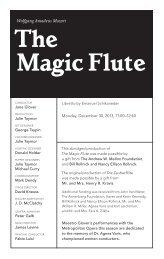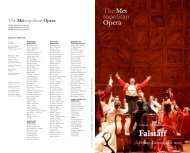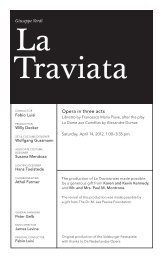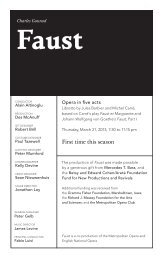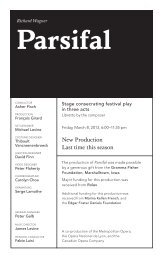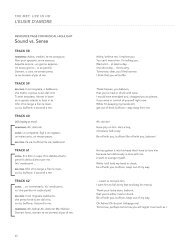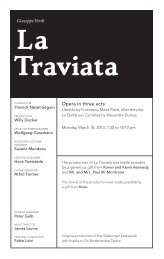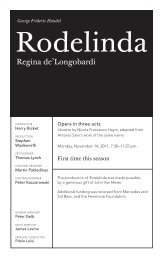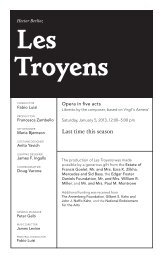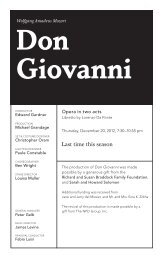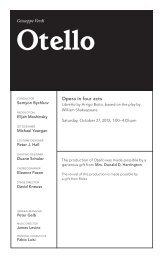Das Rheingold - Metropolitan Opera
Das Rheingold - Metropolitan Opera
Das Rheingold - Metropolitan Opera
You also want an ePaper? Increase the reach of your titles
YUMPU automatically turns print PDFs into web optimized ePapers that Google loves.
airy mountaintops of the gods, with Valhalla seen in the distance; the descent to<br />
Nibelheim and the journey back; Donner, the god of thunder, summoning the<br />
swirling mists, then dissipating them on cue with his hammer, conjuring up a<br />
rainbow bridge over which the gods would walk to their new home…<br />
Wagner eventually overcame all the musical, scenic, and dramatic challenges<br />
he had created. The fact that he not only managed to do so, but that the whole<br />
of the Ring cycle seems to flow effortlessly from <strong>Das</strong> <strong>Rheingold</strong>, raises its stature<br />
from a mere prologue to a theatrical masterpiece all on its own.<br />
Wagner did not wish for any part of the Ring to be staged until the cycle<br />
could be presented as a whole. He realized this would require a “great festival,<br />
to be arranged perhaps especially for the purpose of this performance,” as he<br />
had already mentioned to Liszt before a note of the music had been written.<br />
But against Wagner’s wishes, <strong>Das</strong> <strong>Rheingold</strong> had its premiere in Munich on<br />
September 22, 1869, on the express orders of the composer’s ardent admirer<br />
and patron, King Ludwig II. Another seven years would pass before Wagner was<br />
able to present the Ring in its entirety, in the theater at Bayreuth that was built<br />
specifically for it (and that still serves as the home of the annual Wagner festival).<br />
<strong>Das</strong> <strong>Rheingold</strong> was first heard at the Met on January 4, 1889. The program<br />
carried a note stating that, “For this opera the scenery has been ordered from<br />
Germany and the costumes and armor are from the designs of Prof. Doepier,<br />
who made the original drawings for Richard Wagner.” The one-act opera was<br />
presented with an intermission between the second and third scenes. “This<br />
is the practice of the Imperial <strong>Opera</strong> House in Vienna, and though open to<br />
objection on artistic grounds will doubtless prove a welcome relief,” noted one<br />
New York newspaper the day before the premiere. In fact, Wagner himself had<br />
raised no objections to a break when <strong>Rheingold</strong> was given in Berlin in 1881. The<br />
Met presented the work both with and without intermission well into the 20th<br />
century. In Robert Lepage’s production, the drama unfolds in one uninterrupted<br />
act, as the composer conceived it.<br />
—Paul Thomason<br />
ADDITIONAL EX MACHINA PRODUCTION STAFF Costume and Properties Production Richard Provost,<br />
Valérie Deschênes; Wig and make up research Florence Cornet; Properties Production<br />
Atelier Sylvain Racine, Paul Duval, Boscus, Théâtre de la Dame de Cœur, Créations Fillion, Tridim;<br />
Lighting Assistants Valy Tremblay, David Lavallée; Set Designer Assistants Anna Tusell Sanchez,<br />
Santiago Martos Gonzalez<br />
WORKSHOP PERFORMERS Anne Barry, Geneviève Bérubé, Guillaume Chouinard, Michael Duffy,<br />
Andrea Legg, Guy Lessard, Jacinthe Pauzé Boisvert, Jenny Ritchie, Francis Roberge, Éric Robidoux,<br />
Martin Vaillancourt<br />
lacaserne.net<br />
Yamaha is the official piano of the <strong>Metropolitan</strong> <strong>Opera</strong>.<br />
41



